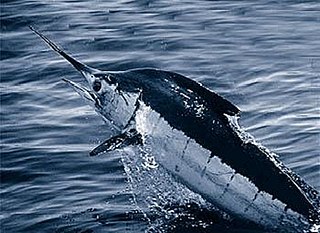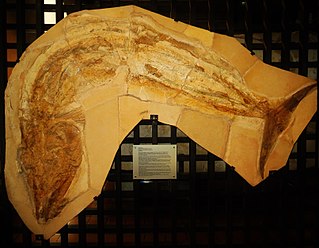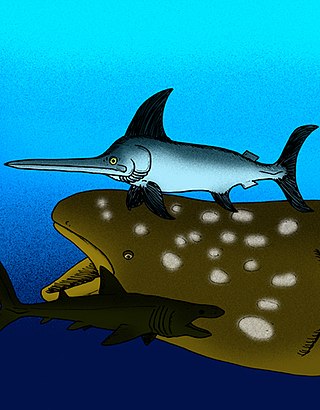
Marlins are fish from the family Istiophoridae, which includes 11 species.

Opahs, also commonly known as moonfish, sunfish, kingfish, and redfin ocean pan are large, colorful, deep-bodied pelagic lampriform fishes comprising the small family Lampridae.

Canobius is an extinct genus of early marine ray-finned fish that lived in the early Carboniferous period (Viséan) of Glencartholm, Scotland.
Blochius is an extinct genus of billfish from the Eocene. It is only known from the Monte Bolca deposits in Italy, and was likely restricted to shallow, tropical waters of the Tethys Ocean.
Baleiichthys is a genus of extinct freshwater ray-finned fish, belonging to the teleosts. It lived in the Middle Jurassic, and its fossil remains have been found in northern Asia. Almost nothing is known about it.
Aetheolepis is an extinct genus of ray-finned fish which lived in freshwater environments in what is now Western Australia and New South Wales during the Jurassic period. It contains one species, A. mirabilis. Aetheolepis was previously thought to be an archaeomaenid, until a 2016 study instead recovered it as a member of the family Dapediidae. Like other dapediids, it had a deep, discoid-shaped body. Fossils of A. mirabilis have been found in the Talbragar River fossil beds of New South Wales and the Colalura Sandstone of Western Australia. It was named by Arthur Smith Woodward in 1865 along with other Talbragar fish.

Australosomus is an extinct genus of prehistoric ray-finned fish that lived during the Early Triassic epoch in what is now Greenland, Kenya, Tanzania, Madagascar, South Africa and Canada.
Cheirodopsis is an extinct genus of prehistoric marine ray-finned fish that lived during the Viséan stage of the Mississippian epoch. It contains a single species, C. geikiei from what is now Glencartholm, Scotland.

Ainia is an extinct genus of prehistoric ray-finned fish that lived during the Kimmeridgian stage of the Late Jurassic epoch. It contains a single species, A. armata, known from the famous Solnhofen Limestone of Germany. It is a distant relative of the bowfin, although it is more closely related to genera such as Caturus and Osteorachis.
Opsithrissops is an extinct genus of prehistoric bony fish that lived during the Thanetian stage of the Paleocene epoch. It is a 120 centimetres (3.9 ft) fish in the family Osteoglossiformes which includes other bony-tongues such as the extant species of arowana and arapaima.

Besania is an extinct genus of prehistoric marine ray-finned fish that lived during the Anisian and Ladinian ages of the Middle Triassic epoch in what is now southern/southeastern Switzerland and northern Italy. Fossils were recovered from the Besano Formation of Monte San Giorgio area and the Prosanto Formation of canton Graubünden, Switzerland.

Asthenocormus is an extinct genus of large marine pachycormiform ray-finned fish. It contains a single species, A. titanius. A member of the edentulous suspension feeding clade within the Pachycormiformes, fossils have been found in the Upper Jurassic plattenkalks of Bavaria, Germany.
Rhinodipterus is an extinct genus of prehistoric dipnoan sarcopterygians or lobe-finned fish, that lived in the Devonian Period, between 416 and 359 million years ago. It is believed to have inhabited shallow, salt-water reefs, and is one of the earliest known examples of marine lungfish. Research based on an exceptionally well-preserved specimen from the Gogo Formation of Australia has shown that Rhinodipterus has cranial ribs attached to its braincase and was probably adapted for air-breathing to some degree as living lungfish are. This could be the only case known for a marine lungfish with air-breathing adaptations.

Xiphiorhynchus is an extinct genus of prehistoric swordfish that lived from the Eocene until the Oligocene. Unlike the modern swordfish, both the upper and lower jaws of Xiphiorhynchus were extended into blade-like points.

Ligulalepis is an extinct genus of stem-osteichthyans which lived from the Silurian to the Early Devonian. Ligulalepis was first described from isolated scales found in the Taemas-Wee jasper limestones of New South Wales by Hans-Peter Schultze (1968) and further material described by Burrow (1994). A nearly complete skull found in the same general location was described in Nature by Basden et al. (2000) claiming the genus was closely related to basal ray-finned fishes (Actinopterygii). In 2015 Flinders University student Benedict King found a more complete new skull of this genus which was formally described by Clement et al. (2018), showing Ligulalepis to be on the stem of all osteichthyans.

Orthocormus is an extinct genus of prehistoric pachycormiform bony fish. It is known from three species found in Late Jurassic (Kimmeridgian) aged plattenkalk deposits in Bavaria, Germany. The species "Hypsocormus" tenuirostris Woodward 1889 from the late Middle Jurassic (Callovian) Oxford Clay is not closely related to the type species of Hypsocormus, and is more closely related to Orthocormus + Protosphyraena, and thus has sometimes been referred to in open nomenclature as Orthocormus? tenuirostris. The species of Orthocormus reached over a metre in length, and are thought to have been pelagic predators.

Phanerosteon is an extinct genus of prehistoric bony fish from the Carboniferous period. The type species, P. mirabile, was recovered from the Calciferous sandstone series (Pennsylvanian), Scotland. A second species, P. phonax was described from the Serpukhovian aged Bear Gulch Limestone lagerstätte in Montana, United States.

Palimphyes is an extinct genus of marine ray-finned fish known from the Paleogene period. It was a euzaphlegid, an extinct family of scombroid fish related to the escolars and snake mackerels.

Tarasiiformes is an extinct order of prehistoric ray-finned fish.

The Lueders Formation is a geologic formation in Texas. It is the top formation of the Albany Group and preserves fossils dating back to the Permian period.













